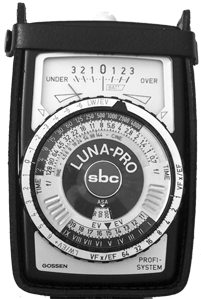
|
  Maker: Gossen Model: Luna-Pro sbc Circa: 1977 Price (new): $200 Cell type: Silicon Blue Measure type: Combination Reflecting/Averaging and 3D Incident. Spot, enlarging, color-temp via attachments Battery: 9 volt |
|
Really, it's an updating of Gossen's high-end Luna-Pro, but they replaced the crappy CdS photocell with a Silicon Blue. CdS ruled the 60s and much of the 70s, but was heavily criticized for having a "memory"—i.e. if you aimed it at very bright light and then shifted to something dimmer, it took a moment (sometimes many moments) for the cell to adjust properly. Older selenium cells didn't have this problem; neither did the newer silicon blues. It was also upgraded to use the "Profi-System"—smart accessories that made electrical connections into the meter, rather than simply snapping on over the sensor. Some of the attachments, like the 5° spot, didn't require anything special, but the color temperature meter did. This is one of the very few modern professional meters in my collection. It's impressive to look at. It's twice as big as almost anything else I own (it looks smaller in advertisements where there's no sense of scale). It runs on 9v batteries, which are bulky but at least I don't worry about obsolecence. Has a lumisphere that can be slid over the sensor so it runs as both a reflectance and an incident meter. On the surface it looks like a simple match-needle analog meter, but a close look at the dial and damn, there's a lot going on. I had to read the book on this one and I'm still learning how to use it. And it takes attachments. I'm a sucker for attachments. I've got the color temperature attachment, a spot attachment, though it's a wide spot like my Sekonic View Meter, and the enlarging attachment. I have the microscope attachment even though I don't have a microscope. Arthur Kramer wrote a column in Modern Photography (I'm not sure which. It was from 1978) where he discussed several of them. He dismissed the flexi-probe as a "cure looking for a disease." The big 3D incident attachment turned out to be superfluous because it matched the readings produced by the small 3D incident dome that's already on the meter. He liked the color temperature attachment, though. Great meter but complicated and it takes time to learn it. It's amazing what this thing can do. It has a kick-ass calculator dial if you learn it, and includes a Zone scale. Another thing about it, and this is largely unique, is that it uses a null system instead of a regular scale. Most analog meters have a needle that sweeps across an arc painted across the face of the meter, and the arc is marked off in something--sometimes candles per square-foot, but more often arbitrary "light values." You read the number that the needle is closest to and use the calculator dial to translate that into camera settings. But with a null meter, the calculator dial is electrically linked to the meter, so when you take a reading you turn the dial until the needle is in the center of the scale (the null position), and then you can read the shutter/aperture pairs. But what you can also easily do is turn the dial one way or the other and move the needle to the Plus or Minus side of the null. The Luna Pro sbc is marked off so you can go plus or minus 3 stops off null. So what? So--it makes it very easy to see contrasts. Let's say you're lighting a portrait and you want 1-1/2 stops difference between the main and the fill. You can do it a variety of ways: you set your meter to null on the main side and then meter the fill, and add light until the needle is minus 1-1/2. Or set the needle plus 1-1/2 on the main and add fill until the meter nulls. Or null the fill and add the main, and so on. You can do the same thing with a regular scale, but the null makes it particularly easy. Plus a lot of scales aren't evenly marked; the numbers are often wide in the middle but crowded on the edges, or wide at the low end and crowded on the bright side, or vice versa. Working the null scale puts you nicely in the center of the dial where it's easy to read. Is it better than other methods? Not necessary, but I like it. It's also very modern, even if it isn't digital: it's boxy and dull. It lacks a certain character that the Westons, Norwoods, even the General Electrics had. It's a hell of a meter, but it has no curb appeal. On the other hand, this is the meter that lives in my camera bag, and it's the first one I reach for when I want a hand-held meter for whatever reason. |
|
©opyright by James Ollinger. All Rights Reserved.
Company names and models are registered trademarks of their respective owners
and are not affiliated with this website in any way.

-s.jpg)